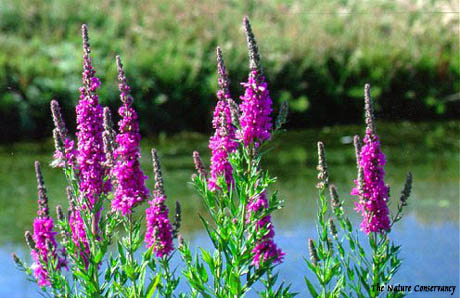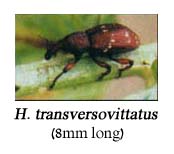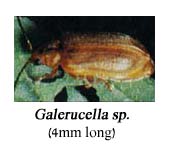|
|
|
|
|
|
|
|
|
||
"If plants were people, purple loosestrife would be Xena, warrior princess" (76, Gutin 1999) |
|
Although Gutin’s desription of the attributes of purple loosestrife is by no means scientific, it is strangely accurate. Purple loosestrife, Lythrum salicaria L., Lythraceae, is commonly known as an aggressive invasive that dominates many wetlands and riparian areas across the northern U.S. and southern Canada. The purple flowered herbaceous plant has many phenotypic characteristics which have aided the establishment and profound prolifieration of multiple populations. The anthropogenic disturbance of wetlands is also considered a facilitotor of invasion by purple loosestrife and other non-native species. In addition, there are no natural enemies (i.e. herbivores or plant pathogens) native to North America that serve as a biological control for purple loosestrife. Most researchers agree that its effects are devastating to wetland diversity of native flora and fauna. To address the continual loss of wetlands and their native species to purple loosestrife a Biological Control Program was implemented in 1992 by the US Department of Agriculture’s Animal and Plant Health Inspecition Service. Studies show that the introduced biological agents, 5 species of beetles which attack different parts of the plant, are found throughout Europe and are host-specific to European varieties of L. salicaria. Only recently have some studies shown that the introduced agents have a deleterious efffect on the growth and development of L. salicaria. Purple loosestrife was first introduced to North America in the early nineteenth century and has subsequently spread across northern U.S. and southern Canada over the past two centuries (Hight et al 1995). Various strains of purple loosestrife have been re-introduced by nurseries as an herb and ornamental (Blossey and Schroeder 1995). Currently, purple loosestrife is considered a serious threat to wetlands as it aggressively invades such areas and displaces native species (Blossey and Schroeder 1995, Hight et al 1995, Lindgren et al 1998, but see Hager and McCoy 1998). Its disturbance to wetland areas threatens not only native flora, which is often outcompeted by purple loosestrife, but also the waterfowl and other fauna that depend upon native species as a source of food. The survival and continual spread of purple loosestrife has been facilitated by anthropogenic disturbance to wetlands and their surrounding lands. Studies suggest that disturbance may be required in order for L. salicaria to establish itself in a wetland (Rachich and Reader 1999).
Purple loosestrife, Lythrum salicaria L., Lythraceae, is a wetland perennial native to Europe. It is an early successional species that can inhabit various open, wet soil environments, and form dense, monospecific stands (Blossey 1993). Purple loosestrife bears many characteristics which aid in its colonization of and persistance in wetland habitats. It produces an abundance of seeds, which are durable and can remain dormant in aquatic or dry climates for a number of years. Seeds are dispersed by wind and water, as is pollen, thus reproduction does not depend upon the presence of other animals. Purple loosestrife also grow a fortified root system, which provide nutrients for above ground material and facilitate regrowth if above ground material is removed or damaged. Purple loosestrife is well-studied among botanists for its unique flower morphologies: each plant has three flower types, a phenomenon coined, heterostyle trimorphism (Gutin 1999). The plant is also well-known among herbal medicinalists, as it is a commonly used treatment for diarrhea, dysentery, bleeding, wounds, ulcers, and sores (Stuckey 1980).
MEANS OF INVASION AND DOMINATION The life history traits of purple loosestrife enhace its ability to invade and dominate wetlands. A single mature plant can produce 2.5 million seeds per year (Blossey and Schroeder 1995). The seeds of purple loosestrife are durable and can remain dormant for long periods of time, thus, making removal of the plants more difficult. Populations of purple loosestrife quickly dominate seed beds, thus making the introduction of native species increasingly difficult (Malecki et al 1993). Wind and water dispersal of seeds, high germination rates, and pollination by generalist pollinators, such as bees, contribute to the prolific reproductive capabilities of L salicaria.(Blossey and Schroeder 1995). In addition to having evolved reproductive characteristics that enable aggressive and extensive invasion, purple loosestrife has a number of phenotypic attributes that crowd out native herbaceous species. Wide-topped crowns inhibit many herbceous plants from accessing direct sunlight. A strong root stock, which serves as an important storage organ, sequester nutrients in the soil and may crowd out below ground growth for other natives. Reserves stored in the roots enable regrowth of above ground shoots if they are cut, burned, or killed by herbicides (Malecki et al 1993). Perhaps most effective in enabling the proliferation of this particular invasive, is the observation that L. salicaria is not attacked to a notable degree by any native North American insect herbivores or plant pathogens (Rachich and Reader 1999, Blossey and Schroeder 1995). In Europe, however, a rich herbivore community of atleast 120 phytophagous insects are associated with purple loosestrife; 14 of these insects are host-specific to purple loosestrife (Malecki et al 1993). Recently, a study in Canada suggested that the mechanism of invasion by L. salicaria is most likely a combination of disturbance to the wetland and the lack of substantial predation by native North American insects and pathogens (Rachich and Reader 1999). A study in Canada by Rachich and Reader (1999) demonstrated that native insect herbivores do not provide a substantial menas of controlling purple loosestrife populations. In plots of L. salicaria, survivorship of plants exposed to herbivores (60-80% plant survival) did not differ significantly from that of plants not exposed to native Canadian herbivores (100% plant survival) (Rachich and Reader 1999).
As of yet, there are no effective long-term methods to control L. salicaria (Lindgren et al 1998). Small localized populations may be controlled by continual cutting and up-rooting of individual plants. Application of herbicides, while effective on a short term basis, do not permanently remove populations from a wetland area (Blossey and Schroeder 1995). Commonly used herbicides are glyphosphate (Rodeo), 2,4-D (Weed-Rhap LV-4D), and slightly less used trilopyr (Garlon 3A). These herbicides are not specific to L. salicaria and thus kill native herbaceous plants in addition to the target species (Blossey and Schroeder 1995). Spraying may kill off most vegetation, thus disturbing the habitat and leaving it vulnerable for invasion by L. salicaria and other wetland invasives (Blossey and Schroeder 1995). Numerous studies have assessed the effectiveness of herbicide use (Rawinski 1982,Balogh 1986, Reinartz et al 1986, Gabor et al 1995, 1996, Lindgren et al 1998). The use of Garlon 3A (triclopyr), has been effective in controlling small adult populations on a short term basis. However, studies by Gabor et al (1995, 1996) demonstrate that application of triclopyr is followed by regrowth of high densities of purple loosetrife seedlings. Thus, herbicide application, which in effect, kills most herbaceous vegetation and exposes areas to colonizing species, may facilitate the reestablishment of purple loosestrife.
The protocol for addressing the loss of biodiversity due to purple loosestrife invasions currently focuses on biological control. Classical biological control of invasive plants, i.e. weeds, useds the negative impact of host-specific herbivores to reduce the competitive ability of nonindigenous plants (Blossey and Schat 1997). The program applied to purple loosestrife is reviewed by its scientific supporters, R.A. Malecki, B. Blossey, S.D. Hight, D. Schroeder, L.T. Kok, and J.R. Coulson (1993), who have published extensively on various issues surrounding the invasive, purple loosestrife. It is thought that machanisms of biological control are more compatible with conservationist efferts and environmental management philosophy. In June 1992, the US Department of Agriculture’s Animal and Plant Health Inspecition Service (USDA-APHIS) approved the introduction of 3 European beetle herbivores of L. salicaria: Hylobius transversovittatus, Galerucella calmariensis, and G. pusilla (Malecki et al 1993). Prior to their relaese, studies had been performed in Europe and in the US to determine the most effective herbivores in survivorship and reproductive abilities of L. salicaria. It was estimated that there existed 120 species of phytophagous insects identified as herbivores on L. salicaria in Europe. Of those 120, 6 host-specific species were chosen as having the most potential as biological control agents in North America (Malecki et al 1993):
Nanophyes marmoratus - flower-feeding beetle which reduces seed production
Nanophyes brevis - flower-feeding beetle which reduces seed production
Bayeriola salicariae - gall midge that attacks flower buds to reduce seed production Based upon a study by Blossey (1991), three species were chosen as biological control agents for release in the U.S: H. transversovittatus and the two Galerucella spp. They were chosen primarily based on their ability to dramatically decrease L. salicaria growth and vigor. There is the possibility, however, that introduced pests will colonize other North American plant species rather than remaining specific herbivores on L. salicaria. Host-specificity tests were performed on approximately 50 plant species, including those in the Lythraceae family and those considered ecologically or economically important to wetlands (Malecki et al 1992). Results showed that the three selected insects consistently preferred L. salicaria. Thus, after demonstrating that H. transversovittatus, G. calmariensis, and G. pusilla were host-specific insects that constrain plant growth and reproduction , they were released in New York, Pennsylvania, Maryland, Virginia, Minnesota, Oregon, Washington, and Canada. Subsequently, in 1994, the two flower-feeding beetles of the Nanophyes genus had been approved for release as well (Blossey and Schroeder 1995). As of 1999, more than 3 million insects have been released on more than 1,200 purple loosestrife sites in more than 30 states. Researchers predict that the effects may not be significant for many years (Malecki et al 1993) The introduction of foreign insects to multiple ares of the U.S, and Canada has sparked further research as to the effectiveness of herbivores on purple loosestrife growth and reproductive capabilities. Some researchers support the introduction of European biological control agents while others question the mechanisms of introduction used. The effects of H. transversovittatus and the two Galerucella spp., introduced in 1992, have been studied more extensively than the two Nanophyes spp which were introduced in 1994.
The effects of herbivores on plants can have a range of effects on a host, depending upon the developmental stage of both the host and the herbivore as well as the environmental conditions within which they interact. It is therefore necessary to study the effects of herbivores using a range of attack levels and measuring effects on all plant parts to reduce the chance of finding misleading information about host-plant interactions (Blossey and Schat 1997). Furthermore, it is necessary to examine the effect of herbivores on host strains that have different histories in their introduction to North America. An agent proven to serve as a mechanism of control may only be successful in a fraction of the weed population. There were many founder populations, purple losestrife was introduced a number of times, especially by garden nurseries. Genetic variation within and among populations is shown to be high (Welling and Becker 1992) The U.S. has imported 28 ornamental varieties of purple loosestrife, including hybrids of European Lythrum salicaria and North American Lythrum spp. Thus, the success of a control agent is reliant upon its ability to attack and harm diversified purple loosestrife populations. Yet, at the same time, the agent must be specific to the host specie of purple loosestrife. The basic underlying assumption of the biological control model applied to purple loosestrife is that the combination of 5 herbivores, which attack different parts of the plant, will have the effect of better weed control. However, one cannot assume that the effect of multiple herbivores is additive. There may exist an interaction between herbivores that could constrain their effects on the plant and reduce deleterious effects to plant growth, survivorship, and reproduction. Foliage feeders, for example, could have a negative effect on the impact of the root-borer, thus resulting in less effective weed control.
There is hesitancy to claim that the biological control program is by any measure controlling or containing the vast number of purple loosestrife populations that continue to spread throughout the northern U.S. and southern Canada. Studies in North America show that the introduced species have established themselves as reproducing populations. Meanwhile studies from Europe clearly demonstrate host-specificty for the 5 introduced insect herbivores. However, there does not exist a large body of evidence showing a) that the introduced biological control agents are host-specific to many diversified populations of purple loosestrife (but see Blossey and Schat 1997); b) that the insect herbivores attack hybrid purple loosestrife strains; or c) that control agents are having a notable influence on the growth, development, and reproductive ability of North American L. salicaria populations. Biological control methods are designed to target the specific invasive and are used to avoid the use of noxious herbicides that destroy native wetland species and often have no long-term effects in controlling purple loosestrife. Clearly, the effectiveness of the biological control agents in North America needs to be addressed more thouroughly in the hopes of showing that the time and money spent on this program is not a fruitless endevour. In addition, Rachich and Reader (1999) propose that a preventative means of the further spread of purple loosestrife is a reduction of disturbance to wetland habitats. Anthropogenic disturbance is likely to be a mechanism by which many foreign species invade native habitats.
Balogh, G.R. 1986. Ecology, distribution, and control of Purple Loosestrife (Lythrum salicaria ) in Northwest Ohio. M.S. Thesis, 111 pp. Ohio State University, Columbus, OH. Blossey, B. 1993. Herbivory below ground and biological weed control: life history of a root-boring weevil on purple loosestrife. Oecologia 94: 380-387. Blossey, B. 1991. Study and screening of potential biological control agents of purple loosestrife (Lythrum salicaria ): final report. CAB International Institute of Biological Control , Delemont, Switzerland. Blossey, B. and M. Schat. 1997. Performance of Galerucella calmariensis (Coleoptera: Chrysomelidae) on Different North American Populations of Purple Loosestrife. Biological Control 26: 439-445. Blossey, B. and D. Schroeder 1995. Host Specificity of Three potential Biological Weed Control Agents Attacking Flowers and Seeds of Lythrum salicaria (Purple Loosestrife). Biological Control 5: 47-53. Gabor, S.G., T. Haagsma, H.R. Murkin, and E. Armson. 1995. Effects of Tripclopyr amine on purple loosestrife and non-target wetland plants in South-eastern Ontario, Canada. Journal of Aquatic Plant Management 33: 48-51. Gutin, J.C. 1999. Purple Passion. Discover 20: 76-81 Hager, H.A. and McCoy, K.D. 1998. The implications of accepting untested hypotheses: A review of the effects of purple loosestrife (Lythrum salicaria ) in North America. Biodiversity and Conservation 7: 1069-1079. Hight, S.D., B. Blossey, J. Laing, and R. Declerck-Floate. 1995. Establishment of Insect Biological Control Agents from Europe Against Lythrum salicaria in North America. Biological Control 24: 967-977. Lindgren, C.J.; T.S. Gabor, and H.R. Murkin. 1998. Impact of Triclopyr Amine on Galerucella calmariensis (Coleoptera: Chrysomelidae) and a Step toward Integrated Management of Purple Loosestrife Lythrum salicaria L. Biological Control 12: 14-19. Malecki, R. A., B. Blossey, S.D. Hight, D. Schroeder, L.T. Kok, and J.R. Coulson. 1993. Biological Control of Purple Loosestrife. BioScience 43:680-686. Rachich, J. and R.J. Reader. 1999. An experiemental study of wetland invisability by purple loosestrife (Lythrum salicaria). Canadian Journal of Botany 77: 1499-1503. Rawinski, T.J. 1982. The Ecology and Management of Purple Loosestrife (Lythrum salicaria ) in Central New York. M.S. Thesis, Cornell University, Ithaca. Reinartz. J.A., J.W. Popp, and M.A. Kuchenreuther. 1986. Purple loosestrife control; minimum glyphosate dose sought (Wisconsin). Restoration Management Notes 4: 834. Stuckey, R.L. 1980. Distributional history of Lythrum salicaria (Purple Loosestrife) in North America. Bartonia 47: 3-20. Welling, C.H. and R.L. Becker. 1992. Life history and taxonomic status of purple loosestrife in Minnesota: implications for management and regulation of this exotic plant. Minnesota Department of Natural Resources, Division of Fish and Wildlife, Special Publication Number 146, St. Paul, MN
last modified 03-25-01 by Christine Lucas ('01), Vassar College, Biology Department. |


